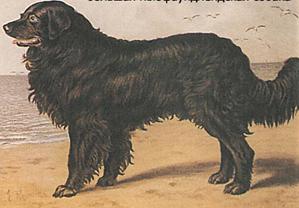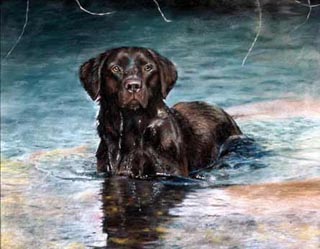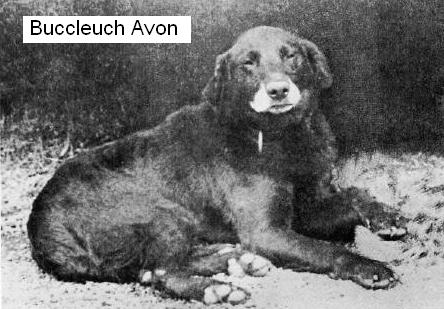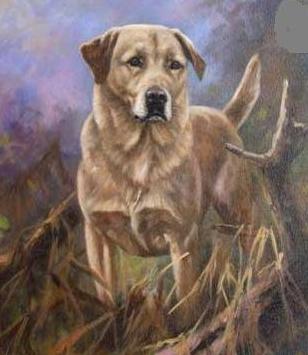The modern labrador's ancestors originated on the island of Newfoundland, now part of the
province of Newfoundland and Labrador, Canada. The breed emerged over time from the St. John's
Water Dog, also an ancestor of the Newfoundland dog (to which the Labrador is closely related),
through ad-hoc breedings by early settlers in the mid to late 16th century. The original
forebears of the St. John's dog have variously been suggested to be crossbreeds of the black St.
Hubert's hound from France, working water dogs from Portugal, old European pointer breeds and
dogs belonging to the indigenous peoples of the area. From the St. John's Dog, two breeds
 emerged; the larger
was used for hauling, and evolved into the large and gentle Newfoundland dog, likely as a result
of breeding with mastiffs brought to the island by the generations of Portuguese fishermen who
had been fishing offshore since the 1400s. The smaller short-coat retrievers used for retrieval
and pulling in nets from the water were the forebears of the Labrador Retriever. The white chest,
feet, chin, and muzzle characteristic of the St. John's Dog often appears
emerged; the larger
was used for hauling, and evolved into the large and gentle Newfoundland dog, likely as a result
of breeding with mastiffs brought to the island by the generations of Portuguese fishermen who
had been fishing offshore since the 1400s. The smaller short-coat retrievers used for retrieval
and pulling in nets from the water were the forebears of the Labrador Retriever. The white chest,
feet, chin, and muzzle characteristic of the St. John's Dog often appears

in Lab mixes, and will occasionally manifest in Labs as a small white spot on the chest or stray
white hairs on the feet or muzzle.
The St. John's area of Newfoundland was settled mainly by the English and
Irish. Local fishermen originally used the St. John's dog to assist in bringing nets to shore;
the dog would grab the floating corks on the ends of the nets and pull them to shore. A number of
these were brought back to the Poole area of England in the early 1800s, then the hub of the
Newfoundland fishing trade, by the gentry, and became prized as sporting and waterfowl hunting
dogs. A few kennels breeding these grew up in England; at the same time a combination of sheep
protection policy (Newfoundland) and rabies quarantine (England) led to their gradual demise in
their country of origin.
 The first and second Earls of Malmesbury, who bred for duck shooting on his
estate, and the 5th and 6th Dukes of Buccleuch, and youngest son Lord George William
Montagu-Douglas-Scott, were instrumental in developing and establishing the modern Labrador breed
in nineteenth century England. The dogs Avon ("Buccleuch Avon") and Ned given by Malmesbury to
assist the Duke of Buccleuch's breeding program in the 1880s are usually considered the ancestors
of all modern Labradors.
The first and second Earls of Malmesbury, who bred for duck shooting on his
estate, and the 5th and 6th Dukes of Buccleuch, and youngest son Lord George William
Montagu-Douglas-Scott, were instrumental in developing and establishing the modern Labrador breed
in nineteenth century England. The dogs Avon ("Buccleuch Avon") and Ned given by Malmesbury to
assist the Duke of Buccleuch's breeding program in the 1880s are usually considered the ancestors
of all modern Labradors. 
Two early descriptions exist. In 1822, explorer W.E. Cormack crossed the
island of Newfoundland by foot. In his journal he wrote "The dogs are admirably trained as
retrievers in fowling, and are otherwise useful. The
smooth or short haired dog is
preferred because in frosty weather the long haired kind become encumbered with ice on coming out
of the water."
Another early report by a Colonel Hawker described the dog as "by far the
best for any kind of shooting. He is generally black and no bigger than a Pointer, very fine in
legs, with short, smooth hair and does not carry his tail so much curled as the other; is
extremely quick, running, swimming and fighting and their sense of smell is hardly to be
credited."
There is some confusion in the naming of the early breed; the breed we now
know as the Labrador Retriever was originally called the St. John's dog (from which it emerged),
or lesser Newfoundland, but these

were also considered distinct breeds by other sources. Other origins suggested
for the name include the Spanish or Portuguese word for rural/agricultural workers, Portuguese
"lavradores" or Spanish "labradores," and the village of Castro Laboreiro in Portugal whose
herding and guard dogs bear a "striking resemblance" to Labradors.
The first written reference to the breed was in 1814 ("Instructions to Young
Sportsmen" by Colonel Peter Hawker), the first painting in 1823 ("Cora. A Labrador Bitch" by
Edwin Landseer), and the first photograph in 1856 (the Earl of Home's dog "Nell", described both
as a Labrador and a St. Johns dog). By 1870 the name Labrador Retriever became common in England.
The first yellow Labrador on
record was born in 1899 (Ben of Hyde, kennels of Major C.J.
Radclyffe), and the breed was
 recognised by the Kennel Club in 1903. The first American Kennel Club
(AKC) registration was in 1917. The chocolate Labrador emerged in the 1930s, although liver
spotted pups were documented being born at the Buccleuch kennels in 1892. The St. John's dog
survived until the early 1980s, the last two individuals being photographed in old age around
1981.
recognised by the Kennel Club in 1903. The first American Kennel Club
(AKC) registration was in 1917. The chocolate Labrador emerged in the 1930s, although liver
spotted pups were documented being born at the Buccleuch kennels in 1892. The St. John's dog
survived until the early 1980s, the last two individuals being photographed in old age around
1981.
Ancestral chocolate and butterscotch-yellow colours (sometimes called
"liver" or "golden") were noted in the original St. John's dogs as early as 1807, when the Canton
shipwrecked carrying a number of St. John's dogs for the Earl of Malmesbury. Two dogs were later
found, one black and one chocolate, evidence that chocolate had been a colour in the original St.
John's dogs. Yellow and chocolate pups, and occasional black and tan or brindling, would
occasionally reappear (although often culled), until finally gaining acceptance in the cases of
chocolate and yellow or being mostly bred out of the breed in the cases of black-and-tan and
brindled, although until the 20th century black was the preferred colour.
The first recognised yellow Labrador was Ben of Hyde, born 1899, and chocolate labs became more
established in the 1930s.
In the early years of the breed through to the mid-20th century, Labradors
of a shade we would now call "yellow" were in fact a dark, almost butterscotch, colour (visible
in early yellow Labrador photographs). The shade was known as "Golden" until required to be
changed by the UK Kennel Club, on the grounds that "Gold" was not actually a colour. Over the
20th century a preference for far lighter shades of yellow through to cream prevailed, until
today most yellow labs are of this shade.

Interest in the darker shades of gold and fox red were re-established by
English breeders in the 1980s, and two dogs were instrumental in this change: Balrion King Frost
(black, born approx. 1976) who consistently sired "very dark yellow" offspring and is credited as
having "the biggest influence in the re-development of the fox red shade", and his
great-grandson, the likewise famous Wynfaul Tabasco (b.1986), described as "the father of the
modern fox red Labrador", and the only modern fox red Show Champion in the UK. Other dogs, such
as Red Alert and Scrimshaw Placido Flamingo, are also credited with greatly passing on the genes
into more than one renowned bloodline.
Jack Vanderwyk traces the origins of all Chocolate labradors listed on the
LabradorNet database (some 34,000 labradors dogs of all shades) to eight original bloodlines.
However, the shade was not seen as a distinct colour until the 20th century; before then
according to Vanderwyk, such dogs can be traced but were not registered. A degree of
crossbreeding with Flatcoat or Chesapeake Bay retrievers was also
documented in the early
20th century, prior to recognition. Chocolate labradors were also well established in the early
20th century at the kennels of the Earl of Feversham, and Lady Ward of Chiltonfoliat.
The bloodlines as traced by Vanderwyk each lead back to three black
labradors in the 1880s—Buccleuch Avon (m), and his sire and dam, Malmesbury Tramp (m), and
Malmesbury June (f). Morningtown Tobla is also named as an important intermediary, and according
to the studbook of Buccleuch Kennels, the chocolates in that kennel came through FTW Peter of
Faskally (1908).


 The first and second Earls of Malmesbury, who bred for duck shooting on his
estate, and the 5th and 6th Dukes of Buccleuch, and youngest son Lord George William
Montagu-Douglas-Scott, were instrumental in developing and establishing the modern Labrador breed
in nineteenth century England. The dogs Avon ("Buccleuch Avon") and Ned given by Malmesbury to
assist the Duke of Buccleuch's breeding program in the 1880s are usually considered the ancestors
of all modern Labradors.
The first and second Earls of Malmesbury, who bred for duck shooting on his
estate, and the 5th and 6th Dukes of Buccleuch, and youngest son Lord George William
Montagu-Douglas-Scott, were instrumental in developing and establishing the modern Labrador breed
in nineteenth century England. The dogs Avon ("Buccleuch Avon") and Ned given by Malmesbury to
assist the Duke of Buccleuch's breeding program in the 1880s are usually considered the ancestors
of all modern Labradors. 

